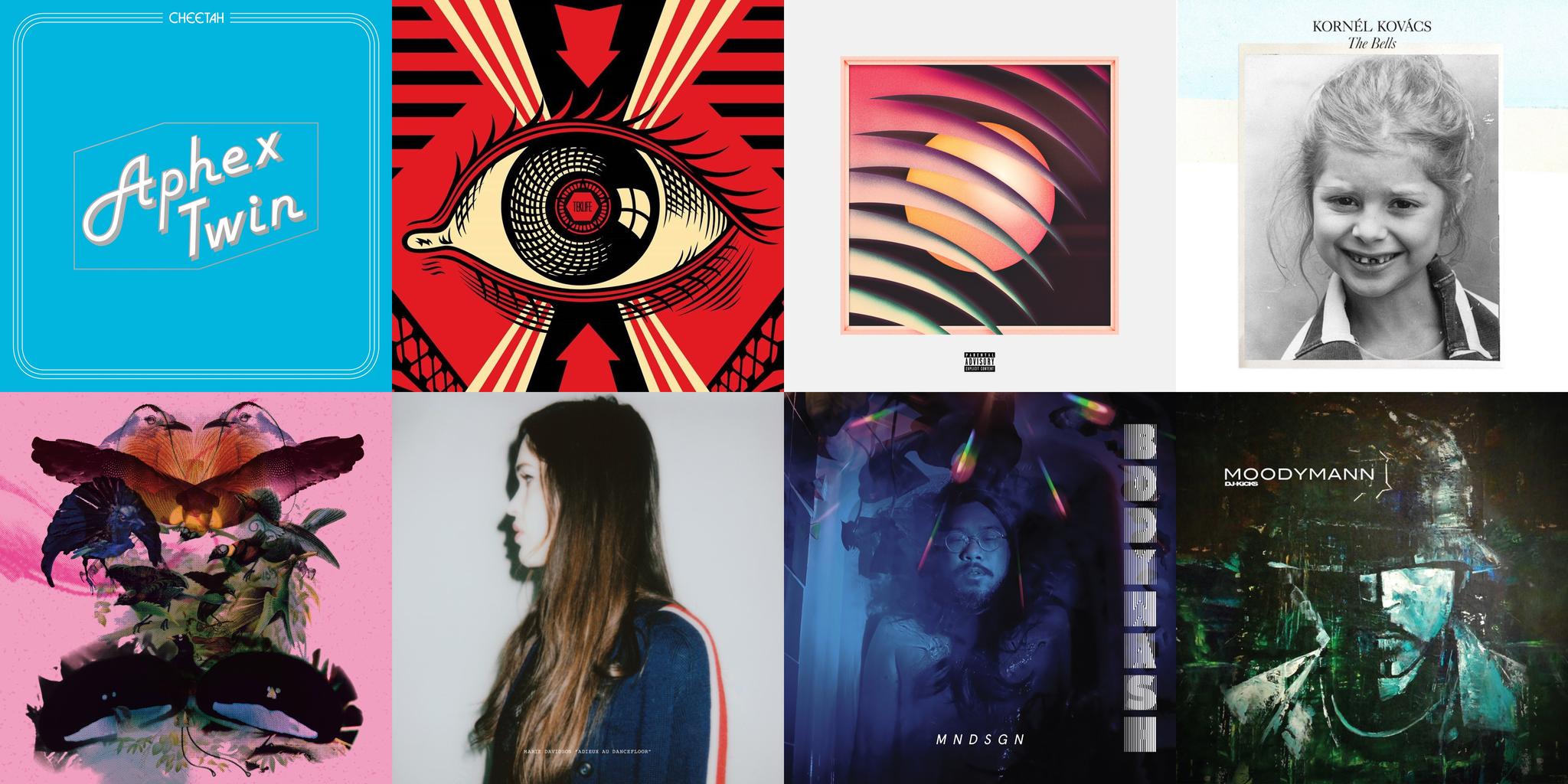
Pitchfork's 20 Best Electronic Albums of 2016
Aphex Twin, the Avalanches, Marie Davidson, and the other artists who led the charge this year
Published: December 08, 2016 06:00
Source

After the vibrant frenzy of *Syro*, Richard D. James slows down. The *Cheetah* EP is a brief but luminescent set of velvety acid and warped sound experiments—made with the notoriously difficult, early ‘90s synth of the same name. As heard on highlights “CHEETAHT7b” and “2X202-ST5,” James makes the most of the challenge.


Raised in Miami and shaped by her career in New York City’s underground clubs, Jessica Gentile delivers a full-length debut that serves as an audio postcard of the places and spaces she’s lived. Full of outrageous fun and welcoming energy, “Bass Supply,” “Wine Up,” and “Stingray Shuffle” repurpose the South Florida styles she grew up on. Like most of the album, “Spa Day” balances hyperactive stimulation with a profound feeling of inner peace—this devout clubgoer\'s Zen-like nourishment.
With the strong musical mind of an expert DJ, a lifetime of club adventures and a string of accomplished EPs, Jubilee delivers her debut album, “After Hours”. It’s a record full of meticulously programmed subbass, 808 and 909 prowess and masterfully restrained, timeless production techniques. It’s Friday night in South Florida, your windows are rolled down and the humid air breezes through your hair as you ride the highway to the rave. You’re piled six deep in a Honda, the subwoofer is cranked up and the radio is just about drowning your laughter. As the ride goes on, and the frequencies change, the sounds move from old school salsa to soca, dancehall to rap, Miami bass to freestyle. You reach the club, lasers are cutting through the thick air and scented smoke machines mask sweatstained jncos. The bass courses through you, makes you feel free, you’re living for the late night. This is the feeling central to Jubilee’s debut full length LP for Mixpak, “After Hours.” An exploration of the New York via Florida producer’s musical history and personal journey, it’s an atmospheric ode to her home state, a confidently crafted nightlife narrative unified by weighty low end and expertly wielded drum machine workouts. “After Hours” is 808s and spring break, it’s the sweet spot while changing the frequencies on the Florida radio dial, a homage to vibing and partying in the 305.

For the past seven years Kornél Kovács has been busy rocking dancefloors and boomboxes worldwide as one third of Stockholm’s Studio Barnhus alongside Axel Boman and Petter Nordkvist. The label and DJ trio is spearheading a new era of fearless Swedish off-centre dance music, straddling the line between the cute and the menacing. Anticipation for Kovács' debut album has been rocketing following stand out releases like 2014's wistful Szikra, last year’s mad party anthem Pantalón on Glasgow's Numbers imprint and the late night groove of Space Jam on Smallville Records. On The Bells, Kovács pops open his trunk full of sounds nicked from the lost and found bins of nightclubs all over the world. From the distorted organ chords of BB to the stripped down trancehall beats of Josey’s Tune and Szív Utca and the title track's cinematic romanticism, it's all of the bells and all of the whistles - further positioning Kovács as one of the most characteristic producers of modern house music. The record was completed in an intense two-week session with Kovács' great friend and studio engineer Matt Karmil in the winter of 2016. Another close friend, artist Malin Gabriella Nordin, has created the album artwork together with her brother Jonas. Prompted directly by Kovács to give his report on the record, Studio Barnhus label boss Axel Boman had the following to say: Kornél's bells will echo far beyond the nervous and trend sensitive ”dance" genre that our label sometimes is associated with, and into pop history. It’s one of our best, most innovative and creative releases to date, and the fact that one of my best friends has managed to do this on the label we share together makes me so proud that I want to cry. ”The Bells” is the reason I dreamed of starting a label in the first place.

Leon Vynehalls second album is unusually well-balanced. His drums, which sound like theyre sampled from old funk and disco LPs, are tough and muscular, but he surrounds them with soft keyboards, wispy strings, and even harp. The result is a take on deep house as dynamic and richly variegated as a slowly rolling rock tumbler full of agates. Saxony sets jazz flute riffs to sprightly bass and a skipping groove; Beau Sovereign layers whispered come-ons over dramatic chords; and Paradisea is an eyes-closed ode to floating weightlessly above the dance floor.
Two years ago I played at Studio 9 in Vilnius, Lithuania. The following day I missed my flight home and ended up spending an extra day, which gave me a chance to explore the city with my friend Linus, who took me to the Contemporary Art Centre. It was there I spotted a book named 'Rojus', that Linus told me translated as 'Paradise'. The word and striking cover of the book stuck in my mind. A few days after returning home, I turned on to a National Geographic documentary named 'Designed To Dance', explaining the courtship rituals of Birds Of Paradise. As I watched, i jokingly began drawing similarities between these birds' attempts to captivate and impress the opposite sex with dance, and the way strangers try to attract one another in clubs and interact on the dance floor. This gave me the idea of creating a record of functional club music, sequenced as if it were a club night, from doors to closing, using samples of these Birds Of Paradise and their habitat. Thus, Rojus.

Cititrax is thrilled to present a full length LP entitled Adieux Au Dancefloor by Montreal based recording artist, Marie Davidson. Marie Davidson has emerged as one of the foremost electronic artists working in contemporary pop today. As a long-time member of Essaie Pas (DFA Records), Davidson has had the opportunity to hone her many talents. She has been participating in the city’s vibrant experimental community for much of her adult life. However, in 2012 she began to unveil compositions under her own name, revealing a solo artist who possessed the combined confidence and vulnerability required to write, produce and perform unaccompanied. Davidson’s intimate solo work is embodied through a host of synthesizers, sequencers and drum machines which coalesce in synchronized harmony, punctuated by vocals, half sung, half spoken in both French and English. She masterfully shapes the overall mood, themes, emotion, expression and intensity of her work, which gives the final result a distinctive, cinematic quality. With Adieux Au Dancefloor, Marie makes a slight departure from her last two releases, via Holodeck (2015) and Weyrd Son (2014), by creating her first fully dancefloor oriented piece of work. Through the 45 minutes of music that comprises the album, she experiments with pop structures, defines her voice, and layers rhythms to make complex and beautiful techno tracks. She closes the album with the title track in classic Chanson style.




The first sound on Nicolas Jaar’s new record Sirens is a flag whipping in a gale. It’s the sort of sound you don’t realize you know until you hear it. But it’s unmistakable. And pregnant with meaning: nation, memory, conquest—but also frailty, a delicate thing buffeted by mercurial winds. The second sound is breaking glass. Nicholas Jaar has been busy. Since 2015, he’s released Nymphs, a series of four EPs, and Pomegranates, an alternate soundtrack to Sergei Parajanov's 1969 film The Colour of Pomegranates. If Nymphs and Pomegranates represent two sides of the coin of Jaar’s work—club and experimental ambient respectively—Sirens, he says, is“the coin itself”: the terrain, the constraints, the material conditions from which the others emerge. Sirens is animated by an ambivalence at the heart of American music: that, in some fundamental sense, the history of American popular culture is a history of theft. The six lush tracks move seamlessly from rock to reggaetón to doo-wop, each exhibiting Jaar’s signature sensitivity to restraint and exuberance, disjuncture and groove, comfort and disquiet. Foregrounded throughout is the question of what these forms—artifacts of empire and its resistance both—can do for us today. Jaar, whose parents lived under dictatorship in Chile and whose grandparents are Palestinian, ascribes to Víctor Jara’s philosophy that you’re making political music whether you want to or not. The injustices of the past weigh heavily on the living, structuring the possibilities of the present. As Jaar sings, “we’re all waiting for the old thoughts to die.” For now, they’re our thoughts too. Jaar composed and recorded all the music on Sirens himself, with one exception: a sample of the Andean folk song “Lagrimas”—tears—which appears, almost unadorned, in the middle of “No,” the fourth track on Siren. “No” recalls the Chilean national plebiscite of 1988, when artists and activists organized millions of Chileans to vote “no”to the dictatorship of Augusto Pinochet. The song is a meditation on the seeming futility of protest against systems that structure our very reality. Over a loping reggaetón beat, Jaar laments, “ya dijimos no, pero el Si está en todo.”We already said no, but the Yes is everywhere. The songs on Sirens are fiercely critical, but they are generous too, even loving. “I made these songs to play for my friends, for people going to see music,” Jaar says. The place he wants to be is liminal: between the precious sense of freedom that only music can provide, and the reality that there’s no escape; between “knowing that we’re trying to get away and knowing that we can’t. That maybe,” he says, “we shouldn’t.” After the glass shatters, a rush of sound, fluttering pianos and synth mingle with the shards. The shimmering music billows and quiets. There is calm. Then the glass shatters again.


The Australian group finally returns with its long-rumored follow-up to *Since I Left You*, the 2000 album that earned them a ravenous following. *Wildflower* is a continuous mix of the wild and weird, another hallucinogenic collage of samples ranging from R&B to orchestral pop. From the calypso-klezmer \"Frankie Sinatra,\" featuring Danny Brown, to Biz Markie chomping over a Beatles sample on \"Noisy Eater,” it’s the tour de force soundtrack to music\'s past and present.

The Range is a digital archaeologist, unearthing deep musical emotion from the obscure sounds he digs up on YouTube. For *Potential*, the Brooklyn producer searched for voices in particular, incorporating them into his alternately lush and dank masses of beats and bass. Anonymous singsong flits ethereally through “Florida,” which skips and struts over thick kicks accessorized with clipped steel-drum ping and banjo pluck. Others, like “1804,” revolve around rapping or toasting by unknown MCs whose words cut a path through nostalgic yet novel combinations of jungle, dubstep, grime, and ambient music.

